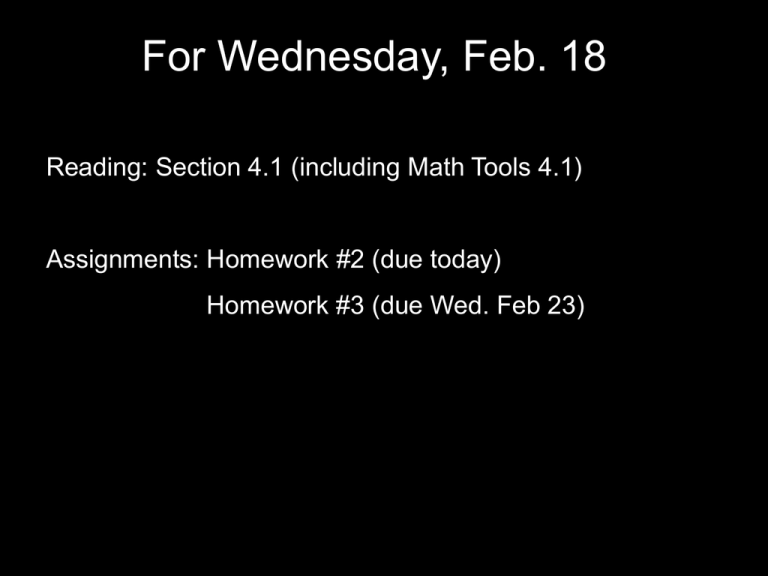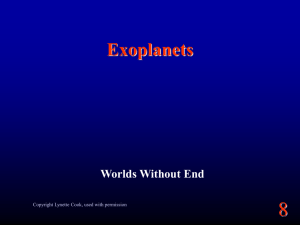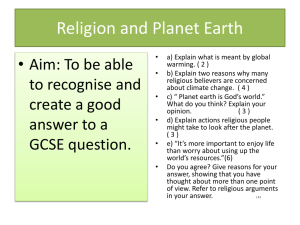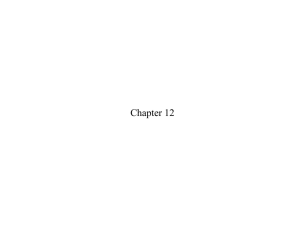force
advertisement

For Wednesday, Feb. 18 Reading: Section 4.1 (including Math Tools 4.1) Assignments: Homework #2 (due today) Homework #3 (due Wed. Feb 23) The “Asteroid Tugboat” spacecraft lands and fires rocket to push asteroid • what direction will the asteroid go? • what if the asteroid is spinning? • how far in advance of a collision do we need to start? Thought Question: Which of the following is an example of constant velocity? A. a car speeding up on a straight road B. a car slowing down on a straight road C. a car maintaining a steady speed on a straight road D. a car speeding up on a curved road E. a car slowing down on a curved road F. a car maintaining a steady speed on a curved road Newton’s Laws of Motion • speed: how fast an object’s position changes measured by speedometers, radar guns • velocity: speed and direction of travel measured by weather vanes • First Law: An object will maintain a constant velocity if there is no net force acting on it. Newton’s Laws of Motion • acceleration: how fast velocity changes 3 ways to accelerate a car: GAS PEDAL (change speed) BRAKE PEDAL STEERING WHEEL (change direction) change in velocity acceleration= time for change Newton’s Laws of Motion • force: strength and direction of a push or pull any effort that can cause acceleration • Second Law: For an unbalanced force, F m a= a: acceleration (units: 2 ) s m m: mass (units: kg) kg × m F: force (units: Newton = 2 ) MASS REDUCES s ACCELERATION Explosion…Bad! trying to blow up a BIG asteroid is not a great idea… … even a big explosion wouldn’t accelerate it much Newton’s Second Law … fragments would keep moving in mostly the same direction Newton’s First Law Thought Question: A ball is attached to a string and swung in a circular path above my head. At the point shown below, I suddenly release the string. If this is viewed from directly above, which of the paths below would the ball most closely follow when released? D E B A VIEW FROM ABOVE: C Orbits are Curved Paths Newton’s First Law says: If object travels on a curved path, there MUST BE an unbalanced force. TOP VIEW: VELOCITY FORCE (friction between tires and road) VELOCITY FORCE (gravity) PATH PATH Newton’s Second Law says: object accelerates (turns) in direction of unbalanced force force is NOT pushing planet forward force IS pulling toward inside of orbit (toward Sun) Thought Question: The picture below shows the velocity of a planet at different times in its orbit (larger arrow means larger speed). 2 Draw the direction of the force on the planet at the different positions shown. For position #3, which combination of these describes the direction the force is acting: A. To the right of the velocity arrow B. To the left of the velocity arrow C. Forward (with the velocity arrow) D. Back (against the velocity arrow) Enter all that apply. 1 3 Ellipse Orbit: PLANET’S VELOCITY (ALWAYS TANGENT TO ORBIT) SUN’S FORCE TURNS AND SPEEDS PLANET SUN’S FORCE JUST TURNS PLANET SUN’S FORCE TURNS AND SLOWS PLANET THE FORCE POINTS TOWARD THE SUN! PLANET’S VELOCITY Newton’s Laws of Motion • Third Law: When one object exerts a force on a second object, second object exerts an equal and opposite force back on the first. EXAMPLES: GAS FORCE ON ROCKET ROCKET’S FORCE ON GAS USA SKATER FORCES ON EACH OTHER ICE Measuring New Planets Newton’s Third Law: star moves slightly as planet orbits “wobble” of star depends on star and planet masses, and size of planet orbit PLANET’S FORCE ON STAR STAR’S FORCE ON PLANET Thought Questions: A compact car and a large truck collide head-on and stick together. 1) Which one feels the largest force during the collision? 2) Which one receives the largest acceleration? (Enter both letters of your answers, then hit “Enter”.) A. The car. B. The truck. C. Both experience the same amount. D. You can’t tell without knowing how fast they were moving before the collision. Newton’s Third Law Forces have equal strength, but accelerations may differ: MAN’S FORCE ON BOAT FORCE BOAT’S FORCE ON MAN FORCE MORE MASS, LESS ACCELERATION For Friday, Feb. 20 Reading: Section 4.2 (including Math Tools 4.2), Appendix 7 Assignments: Homework #3 (due Mon. Feb. 23) Asteroid Ida (and Dactyl) 54 km The “Gravity Tractor” satellite uses rocket to hover near asteroid • What direction will the satellite pull the asteroid? • How long would it take to deflect the asteroid enough? Thought Question A hypothetical planet system has planets in equally-spaced circular orbits. The planet masses are given in terms of the mass of the innermost planet. Which of the planets exerts the greatest gravitational force on the star? A. B. C. D. 16 M 10 M 3M 1M 4 AU 3 AU 2 AU 1 AU Universal Gravitation m1 m2 d Gm1m2 Fg = 2 d Fg: force m1, m2: masses d: distance between centers of objects G: universal gravitational constant 3 m -11 G = 6.67 ´10 kg × s2 attractive force: always pulls masses together equal strength forces pull on both masses Thought Question: At which positions does a rocket feel a greater gravitational force from Earth than from the Moon? Earth is about 80 times more massive than the Moon. (There may be more than one answer.) A B USA C Weight on Planets Rplanet d (radius of planet) planet’s gravity is made up of pulls from every bit of its mass… The bigger the planet, the farther you are from most of the mass strength of force is same as if WHOLE mass is distance d = Rplanet away Fweight = GM planet myou 2 Rplanet Thought Question: An astronaut goes on the first mission to Mars. Mars has a mass that is only about 1/10th the mass of Earth, and it is ½ the size. How will the astronaut’s weight on Mars compare to their weight on Earth? A. The same as on Earth B. 1/2 (50%) the weight on Earth C. 2/5ths (40%) the weight on Earth D. 1/4th (25%) the weight on Earth E. 1/5th (20%) the weight on Earth F. 1/10th (10%) the weight on Earth Your weight will be: 1/10 22 4 = = 2 (1/2) 10 10 or 40% what it is on Earth Mass in Astronomy Moon: 7 1022 kg 1/80th Earth Earth: 6 1024 kg Jupiter: 2 1027 kg 300 Earth Sun: 2 1030 kg 1000 Jupiter 300,000 Earth . Center of Mass m1 v1 r1 r2 v2 m2 center of mass r1 r2 Center of Mass “balance point” is closer to more massive object: r2 m1 = r1 m2 For Monday, Feb. 23 Reading: Review Section 4.2 (and Math Tools 4.3) Assignments: Homework #3 (due Mon. Feb. 23) QUIZ #2 is NEXT FRIDAY Dwarf Planet Ceres Thought Question: If two stars are orbiting each other (and star 1 is more massive than star 2), how does the distance of the center of mass from star 1 (r1) compare to the total separation A? 1 2 11 2 2 A = r +r æ m2 ö A. r1 = ç ÷ A è m1 ø B. æ m1 ö r1 = ç ÷ A è m2 ø r1 C. æ m2 ö r1 = ç ÷A è m1 + m2 ø æ m1 ö D. r1 = ç ÷A è m1 + m2 ø mr =m r E. æ m1 + m2 ö r1 = ç ÷A è m1 ø F. æ m1 + m2 ö r1 = ç ÷A è m2 ø A m2 m1 center of mass Example: Earth and Moon The Earth has about 80 times the mass of the Moon, and the distance to the Moon is about 60 Earth radii. How far is the center of mass from the center of Earth? m1 center of mass? r1 m2 r2 r1 + r 2 = 60RE m1 r1 + ( )r1 = 60RE m2 m1 (1+ )r1 = 60RE m2 81r1 = 60RE 60 r1 = RE 81 Thought Question: For the Earth and the Moon, answer one letter for each of these: A. More force acts on Earth than Moon B. More force acts on Moon than Earth C. The same amount of force acts on both A. B. C. Earth is accelerated more than Moon Moon is accelerated more than Earth Both are accelerated the same amount A. B. C. Earth moves faster than Moon Moon moves faster than Earth Both move at the same speed mMoon mEarth center of mass v1t Center of Mass m1 • If center of mass is to remain between two moving objects, less massive object must move faster in exact opposite direction r1 v 2 r2 m1 = = v1 r1 m2 • From Newton’s 3rd Law: F1 = m1a1 = m2a2 = F2 r2 m2 v 2t a2 m1 = a1 m2 less massive object accelerates more Acceleration due to Gravity Galileo’s Experiment: Two different masses dropped at same time hit ground at same time… equal accelerations! At Earth’s surface, force is GM E m F = mg = 2 RE which creates an acceleration: GM E g= 2 RE that doesn’t depend on the mass of the object dropping! Thought Question In which of the following situations would it be harder to drive along the curve without skidding out? A. B. C. D. Slow speed into a sharp turn Slow speed into a gentle turn High speed into a sharp turn High speed into a gentle turn TOP VIEW: Acceleration Needed for Circular Path a a v v r v circ 2pr = P distance traveled by ball in one circuit (total change in position during orbit) “distance” traveled by tip of velocity arrow during one circuit 2p v æ v ö v2 acirc = = ç ÷v = P èrø r (total change to velocity arrow during orbit caused by the acceleration) Circular Orbit Speed If gravity is providing the acceleration to keep something on a circular path: a v r GM vcirc = r mass of object pulling (NOT the one orbiting) distance between objects (usually radius of orbit) r M General Form of Kepler’s Third Law 4p 3 P = A GM total 2 2 Mtotal: total amount of mass involved (example: star plus planet) • applies to any elliptical orbit • applies to any pair of orbiting masses (Sun + planet; Earth + satellite; Jupiter + moon;…) AN ASTRONOMER’S MAIN WAY TO DETERMINE MASS! …just need orbital period and average orbital distance Forms of Kepler’s Third Law æ P ö æ A ö ÷ ç ÷ =ç è 1 yr ø è 1 AU ø 2 3 • only applies to objects orbiting Sun • meant to be used with units of yrs and AU 4p 3 P = A GM total 2 2 • applies to any pair of orbiting masses (Sun + planet; Earth + satellite; Jupiter + moon; star + star; …) • one object might not dominate mass Mtot (like Pluto + Charon) • make sure units work out! Measuring Planet Orbits Can measure size of planet’s orbit (A) if: PLANET’S FORCE ON STAR • measure P from star’s wobble • determine M for star from its light (and as long as Mplanet << Mstar) STAR’S FORCE ON PLANET 4p 3 P = A GM total 2 2








